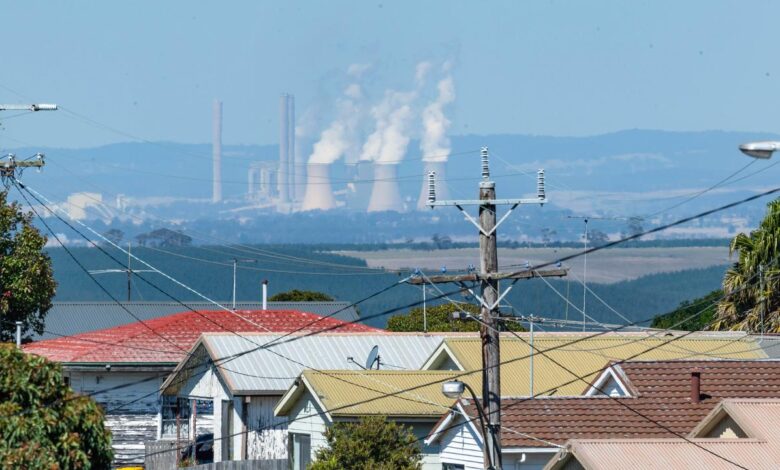Communities near coal-fired power stations support closure of sites and switch to renewables

Communities near Australia’s ageing coal-burning power stations support the closure of the polluting technology and want to see more done to assist the shift to renewables.
Research conducted by YouGov and commissioned by the Environment Victoria and the Nature Conservation Council, surveyed 300 people in the Latrobe Valley in Victoria, and another 300 in the Hunter region in New South Wales.
Across both states, more than 76 per cent agreed the governments should do more to transition to renewable sources of power.
It also found 57 per cent of respondents in the Latrobe Valley would support the early shutdown of the Loy Yang power station if there was a solid plan to support workers, and around 70 per cent agreed coal-fired power states should be retired in the next 10 years with support for workers to retrain.
The results come in stark contrast to a belief often touted by Australian Prime Minister Scott Morrison that Australians overwhelmingly support coal production.
Mr Morrison told the COP26 summit in Glasgow last year that the coal industry would continue operating in the country for “decades”.
“For all of those working in the coal industry in Australia, they will continue to be working in that industry for decades to come,” he told reporters, after a landmark agreement between more than 200 countries to move away from fossil fuels at a faster pace.
“I make no apologies for Australia’s standing up for our national interests, whether they be our security interests or economic interests. We have a balanced plan to achieve net zero by 2050, but we’re not going to make rural and regional Australians pay for that,” the Prime Minister added.
It comes as Australia’s top polluter AGL prepares to deliver a market update, which is expected to include new climate targets and an earlier closure date for the power station.
Environment Victoria chief executive officer Jono La Nauze said it was time for governments to step up.
“With the Australian Energy Market Operator (AEMO) forecasting that all Victorian coal power stations could close by 2032, the need for a community-led transition plan is more urgent than ever,” Mr Nauze said.
“Currently the Latrobe Valley Authority is only funded until mid 2022. We’re calling on the Victorian government to extend this funding until the last power station closes, and to work with locals to build a community-led transition plan for the region.”
In NSW, there was little support for Australia’s “gas-led recovery”, with 60 per cent of those surveyed in the Hunter region saying large scale renewable energy such as wind, solar and hydrogen should be the priority once all coal-fired power stations were retired. Another 8 per cent thought battery storage should be prioritised.
Just 3 per cent supported gas, while 20 per cent wanted to see more coal power come online.
It comes as Labor announced its backing for the Morrison Government-backed $600 million Kurri Kurri gas-fired power station in the Hunter Valley if it is run on green hydrogen fuel by 2030.
Nature Conservation Council acting Chief Executive Jacqui Mumford said the results showed locals wanted a clear plan to support industries to make the switch to clean energy.
“Pretending this energy transition isn’t happening helps no one. We need power station owners to come clean with realistic closure dates by 2030, so the community can plan ahead,” Ms Mumford said.
“We need all governments to take a much more active role in planning a transition for workers and the community.
“It’s time for politicians to catch up with the community.”
Around 68 per cent thought switching to renewable power over the next 10 years was the best option for NSW as long as there was a plan to look after power station workers and the community.
The survey also found overwhelming support for action to make sure power station owners were responsible for the clean-up and rehabilitation of sites after they were closed, with 90 per cent in Victoria supporting this, and 91 per cent in NSW.
Governments should also support heavy industry to switch to affordable, renewable energy, with 80 per cent supporting this in Victoria and 84 per cent in NSW.
Latrobe Valley community advocate Tony Wolfe, who is a senior operator at Loy Yang Power Station said the owners of the sites had irreversibly changed the landscape while collecting massive financial rewards.
“The Latrobe Valley community deserves to have our land returned in pristine condition, and the State government needs to ensure sufficient training and support for displaced workers so they can convert to the new clean energy industries,” he said.
“This presents a perfect opportunity to engage our local indigenous communities to guide us on the future stewardship of this land.”




